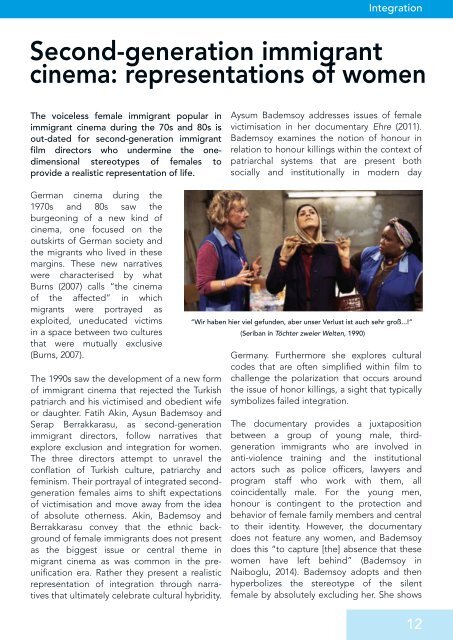Immigration in Berlin
A collection of scientifically-inspired articles written by the students of the course Immigration in Electoral Democracies at the Humboldt - Universität zu Berlin (Summer Semester 2015)
A collection of scientifically-inspired articles written by the students of the course Immigration in Electoral Democracies at the Humboldt - Universität zu Berlin (Summer Semester 2015)
You also want an ePaper? Increase the reach of your titles
YUMPU automatically turns print PDFs into web optimized ePapers that Google loves.
Integration<br />
Second-generation immigrant<br />
c<strong>in</strong>ema: representations of women<br />
The voiceless female immigrant popular <strong>in</strong><br />
immigrant c<strong>in</strong>ema dur<strong>in</strong>g the 70s and 80s is<br />
out-dated for second-generation immigrant<br />
film directors who underm<strong>in</strong>e the onedimensional<br />
stereotypes of females to<br />
provide a realistic representation of life.<br />
Aysum Bademsoy addresses issues of female<br />
victimisation <strong>in</strong> her documentary Ehre (201 1 ).<br />
Bademsoy exam<strong>in</strong>es the notion of honour <strong>in</strong><br />
relation to honour kill<strong>in</strong>gs with<strong>in</strong> the context of<br />
patriarchal systems that are present both<br />
socially and <strong>in</strong>stitutionally <strong>in</strong> modern day<br />
German c<strong>in</strong>ema dur<strong>in</strong>g the<br />
1 970s and 80s saw the<br />
burgeon<strong>in</strong>g of a new k<strong>in</strong>d of<br />
c<strong>in</strong>ema, one focused on the<br />
outskirts of German society and<br />
the migrants who lived <strong>in</strong> these<br />
marg<strong>in</strong>s. These new narratives<br />
were characterised by what<br />
Burns (2007) calls “the c<strong>in</strong>ema<br />
of the affected” <strong>in</strong> which<br />
migrants were portrayed as<br />
exploited, uneducated victims<br />
<strong>in</strong> a space between two cultures<br />
that were mutually exclusive<br />
(Burns, 2007).<br />
The 1 990s saw the development of a new form<br />
of immigrant c<strong>in</strong>ema that rejected the Turkish<br />
patriarch and his victimised and obedient wife<br />
or daughter. Fatih Ak<strong>in</strong>, Aysun Bademsoy and<br />
Serap Berrakkarasu, as second-generation<br />
immigrant directors, follow narratives that<br />
explore exclusion and <strong>in</strong>tegration for women.<br />
The three directors attempt to unravel the<br />
conflation of Turkish culture, patriarchy and<br />
fem<strong>in</strong>ism. Their portrayal of <strong>in</strong>tegrated secondgeneration<br />
females aims to shift expectations<br />
of victimisation and move away from the idea<br />
of absolute otherness. Ak<strong>in</strong>, Bademsoy and<br />
Berrakkarasu convey that the ethnic background<br />
of female immigrants does not present<br />
as the biggest issue or central theme <strong>in</strong><br />
migrant c<strong>in</strong>ema as was common <strong>in</strong> the preunification<br />
era. Rather they present a realistic<br />
representation of <strong>in</strong>tegration through narratives<br />
that ultimately celebrate cultural hybridity.<br />
“Wir haben hier viel gefunden, aber unser Verlust ist auch sehr groß...!”<br />
(Seriban <strong>in</strong> Töchter zweier Welten, 1 990)<br />
Germany. Furthermore she explores cultural<br />
codes that are often simplified with<strong>in</strong> film to<br />
challenge the polarization that occurs around<br />
the issue of honor kill<strong>in</strong>gs, a sight that typically<br />
symbolizes failed <strong>in</strong>tegration.<br />
The documentary provides a juxtaposition<br />
between a group of young male, thirdgeneration<br />
immigrants who are <strong>in</strong>volved <strong>in</strong><br />
anti-violence tra<strong>in</strong><strong>in</strong>g and the <strong>in</strong>stitutional<br />
actors such as police officers, lawyers and<br />
program staff who work with them, all<br />
co<strong>in</strong>cidentally male. For the young men,<br />
honour is cont<strong>in</strong>gent to the protection and<br />
behavior of female family members and central<br />
to their identity. However, the documentary<br />
does not feature any women, and Bademsoy<br />
does this “to capture [the] absence that these<br />
women have left beh<strong>in</strong>d” (Bademsoy <strong>in</strong><br />
Naiboglu, 201 4). Bademsoy adopts and then<br />
hyperbolizes the stereotype of the silent<br />
female by absolutely exclud<strong>in</strong>g her. She shows<br />
1 2


